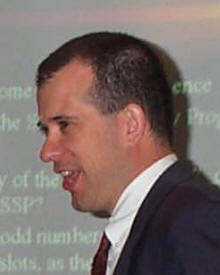 |
Vortices are the sinews and muscles of fluid motions. –Dietrich Küchemann, Aerodynamicist (1965) |
|
Dr. Jonathan C. French received his B.S. in Mechanical Engineering (with High Honors) from Worcester Polytechnic Institute in May 1991. He then joined the University of Tennessee Space Institute where he earned a Master of Science degree in Mechanical Engineering in December, 1993. He also received a Ph.D. in Engineering Science and Mechanics in December, 1996. His graduate work focused on computational aero-acoustics, which has helped him extend geometrically simplified analytic stability equations into numerical tools applicable to complex geometries. Through his research, he established the viability of a new dispersionless numerical method for the Helmholtz equation under a NASA Lewis (Glenn) grant. After presenting this numerical method to an international forum in Munich, Germany, he extended the approach to acoustics problems involving inhomogeneous media. He also modeled the exit flow from a jet turbofan for use in acoustic analyses under a NASA Lewis (Glenn) research contract. Along similar lines, he designed a graphical interface and coordinated the implementation of three computational codes for a jet inlet acoustics design program under a GM Allison contract. After a brief stint as an Acoustics Consultant to AeroAstro (computing 3D acoustic modes of a liquid rocket engine), he joined Lockheed Martin Tactical Aircraft Systems where he performed warfare Monte-Carlo simulations of ground control responses to incoming aircraft attack. He then joined Software and Engineering Associates (SEA*), Carson City, Nevada, in March 1998. At SEA, he improved and developed
new modules for solid rocket propulsion analysis software. He
extended the capabilities of the Solid Performance Program (SPP)
to include improved perimeter computation, generation of 3D FEM
surface meshes of the propellant grain during burnback,
automated grid generation, and an axially burning embedded wire
model. Under a Navy SBIR for solid rocket motor combustion
stability, he developed a 3D acoustic eigensolver code linked to
the SPP code for combustion stability analysis. Through a second
Navy SBIR for non-linear SRM combustion stability modeling, he
improved the linkage between SPP and the Standard Stability
Prediction program (SSP), and implemented non-linear analysis
procedures for prediction of limiting pressure amplitudes. He
managed four research subcontractors, convened two workshops on
non-linear combustion stability modeling, and presented linear
and non-linear combustion stability results at several AIAA
Joint Propulsion and JANNAF conferences, and at a Defense
Exchange Agreement meeting at ONERA in France (most papers
available online at http://www.seainc.com/papers). In addition to his research and
development intensive efforts, he has been active in teaching
and organizing workshops on combustion instability. He has
guest-lectured on rocket combustion stability codes and
nonlinear combustion stability at the University of Tennessee
Space Institute. He has also taught a course on the
implementation of a nacelle acoustic radiation code at Rolls
Royce Allison, at the same time correcting the code to
incorporate the effect of impedance from acoustic liners. *SEA’s mission is to develop and maintain design codes for the aerospace industry. Their codes are intended for use in the design cycle, and as such must return reasonable results quickly. SEA maintains the JANNAF standard design codes for solid and liquid propulsion systems. Through research contracts and industry support, SEA adds new features to permit their codes to address new problems. SEA maintains a sustainable business by adding new features to existing design codes and then providing upgrades to the entire U.S. rocket community. |
|